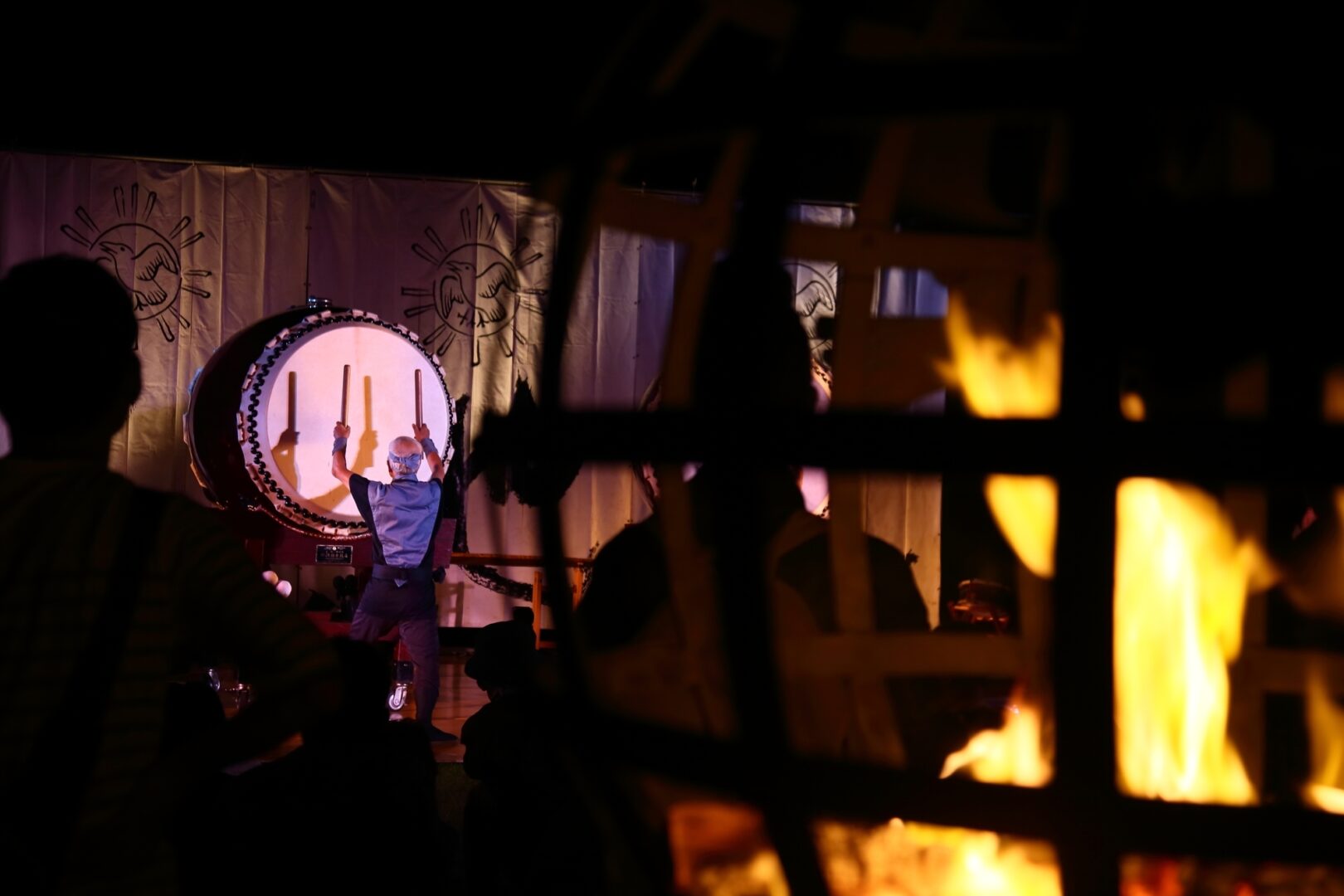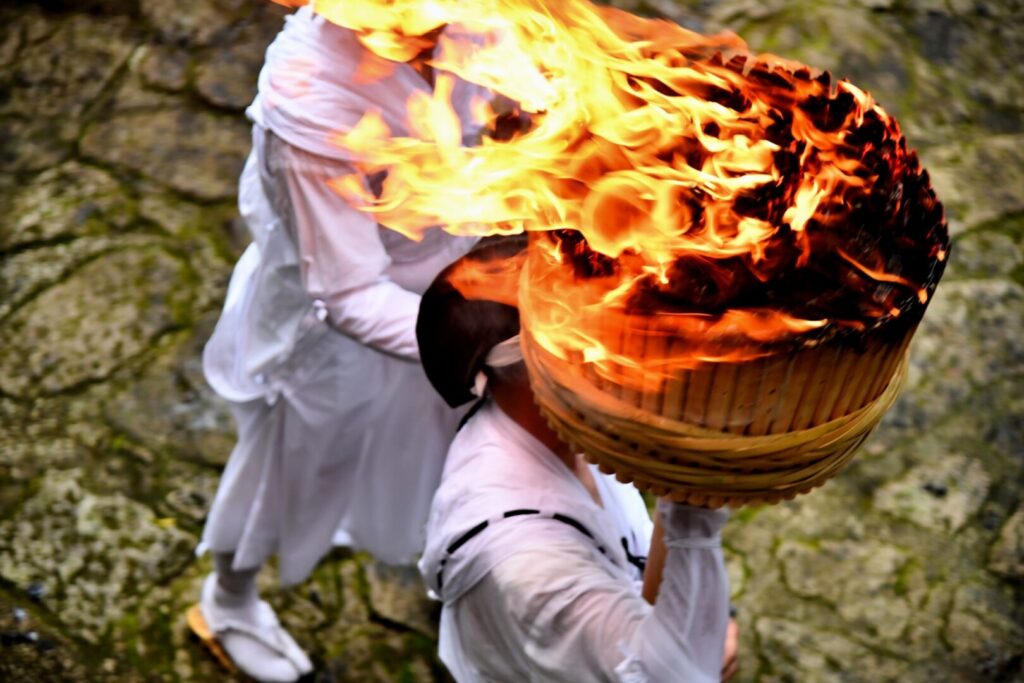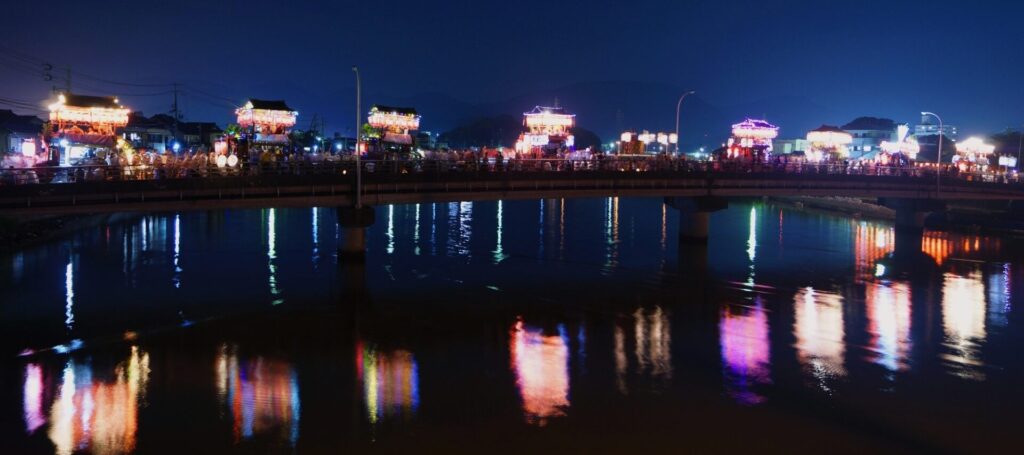

World Heritage Site, Kumano Kodo, to visit if you go there. 10 historic festivals with a long history

The Kumano Kodo is a World Heritage Site.Since ancient times, many people have walked this ancient road to the Kumano Sanzan (Kumano Hongu Taisha, Kumano Nachi Taisha and Kumano Hayatama Taisha) in Wakayama Prefecture.
The Kumano Kodo dates back to the Heian period (794-1185), and as a place with a long history, many historic festivals remain.In this issue, we introduce the traditional festivals of the region for each month of the year in which they are held!These are festivals that you should definitely visit at least once.
[February] Hana no Kutsujinsha Spring Festival
Hana no Kutsu (Iwaya), located along the Kumano Kodo, is the oldest shrine in Japan, mentioned in the Chronicles of Japan. It is believed to be the mausoleum of Izanami no Mikoto. The Spring Festival is held to pray for a good harvest and to receive blessings from the gods. The autumn festival is also held in autumn.
In the Otsunagake Shinto ritual, designated as an Intangible Folk Cultural Asset by Mie Prefecture, Arima’s clansmen and tourists pull a rope of more than 160 metres from the sacred object, a giant rock 45 metres high, and pass it into the grounds of the shrine. The Ootuna is made of seven ropes made of ancient rice straw, tied together to represent the seven gods born to Izanami-no-mikoto. As the previous year’s rope is not replaced, two ropes may be seen being hung, which is believed to indicate a good harvest. The festival is a must-see for its spectacular spectacle.
Venue.
Hana-no-Kutsu Shrine
Traffic access.
2 mins by bus from JR Kumano City Station to Shingu Station, alighting at Hana no Kutsu (Cave of Flowers).
Nearest station
JR Kumano City Station
Features.
Rope-playing Shinto ritual
Date held
2 February every year
Organisers/operators.
Kumano Tourist Association
0597-89-0100
Official website
https://hananoiwaya.com/hananoiwaya/iwaya_index.html
[April] Kumano Hongu Taisha Spring Festival
The largest festival held at the Kumano Hongu Taisha shrine, one of the three Kumano mountains, is the Spring Festival. It takes place over three days from 13 to 15 April every year.
Of the three days, the most famous is the Yunobori Shinji on 13 April. About 50 people, including priests, shrine parishioners, Kagura performers and children, walk from the Kumano Hongu Taisha shrine to Yunomine Onsen, singing Shinto songs to the accompaniment of taiko drums. The children are not allowed to drop to the ground, as it is believed that the deity dwells in their heads, and they are carried on their shoulders throughout the procession.
Once they reach Yumine Onsen, the Yunomine Oji performs the Yasabakashinji, in which the child beats a drum and the father on his shoulders rotates his body. Afterwards, the procession walks again towards the former shrine site of Osaibara.
On the 15th, the final day of the festival, the Honden Matsuri is held at the main shrine of the Hongu Taisha shrine, followed by the Togyo Matsuri from the Hongu Taisha to Oosaihara. The festival includes a parade of portable shrines decorated with chrysanthemums, Yamatomai dances performed by local children and miko (shrine maidens) dances.
Venue.
Kumano Hongu Taisha shrine
Traffic access
140 minutes by direct bus from Nanki Shirahama Airport, 60 minutes by bus from JR Shingu Station, 120 minutes by bus from JR Kii Tanabe Station.
Nearest station
JR Kii Tanabe station
Features.
Yuto ritual, Mikoshi (portable shrine), Yamato dance, miko (shrine maiden) dance
Dates.
13-15 April every year.
Organisers/operators.
Kumano Hongu Taisha
Official website
[May] Funatama Shrine Festival
A festival is held at Funatama Shrine on 3 May during Golden Week. This Funatama Shrine is said to be the inner sanctuary of the Kumano Hongu Taisha shrine and is located upstream from the Otonashi River, which leads to the Hongu Taisha shrine. It is said to be the place where Kumano Gongen (Susanoo-no-mikoto) devised a boat when he trained at Tama-no-taki Waterfall, and many fishermen also visit the shrine as the god of boats. A Shinto ritual at the neighbouring Tamahime Inari is also held on the same day.
After the ritual, a rice cake-throwing and karaoke competition is held, which attracts many visitors every year, especially during Golden Week. (There will be no karaoke competition in 2023.)
Venue.
Funatama Shrine
〒647-1744 Mikoshi, Hongu-cho, Tanabe City, Wakayama Prefecture
Traffic access
Bus from Kii-Tanabe Station ⇒ 9-minute walk from Hatsushinmon Oji bus stop.
Nearest station
JR Kii Tanabe Station
Features.
Mochimaki, karaoke
Dates.
3 May every year
Organisers/operators.
Kumano Hongu Taisha
Official website
[July] Kawachi Festival (Mifune Matsuri)
The Kawachi Matsuri festival takes place on the fourth Saturday and Sunday of July, when decorated boats sail around the island amidst the sound of ragaai (shellfish) on the Kozagawa River in southern Wakayama Prefecture. Designated as a national Important Intangible Folk Cultural Asset, the festival is said to be a manifestation of the Kumano naval force’s victory in the Genpei War. The festival has been held for so long that it is mentioned in the Kii Shoku-fudoki.
Five districts in the Kozagawa river basin, where the fishing industry is flourishing, are responsible for this festival. The boats sail to Koottama, a small island in the river that is considered to be the sacred body of the deity, and worship is performed. Yoimiya is held on Saturday and the main festival on Sunday, during which three boats and a yakatabune float up the river, as seen in a picture scroll. The festival also features a lion dance performance of the Koza school and an oar-denma race by local chu students.
The survival of the festival was threatened by a lack of bearers, such as a shortage of singers for the boat chants, but in 2023 several organisations agreed to cooperate and the festival was successfully held. We would like to preserve this festival for future generations.
Venue.
〒649-4115 Koza, Kushimoto-cho, Higashimuro-gun, Wakayama Prefecture (mouth of Koza River)
Traffic access
3-minute drive from Koza station (parking available).
Nearest station
Furusatsuki Station
Features.
Waterborne procession by luxury boats, no stalls
Dates.
4th Saturday and Sunday of July
Organisers/operators
Executive Committee of the Kumano Suigun Kozakawachi Festival Evening
0735-62-0557 (Kushimoto Town Hall Industry Section), 0735-62-3171 (Nanki-Kushimoto Tourist Association)
Official website
https://www.town.kushimoto.wakayama.jp/kanko/event/koutimaturi.html
[July] Nachi Fire Festival (Kumano Nachi Taisha regular festival, fan festival).

The annual festival of Kumano Nachi-taisha is held on 14 July every year. It is sometimes referred to as the ‘Nachi Fire Festival’, and some of you may have heard of it.
Since ancient times, people have worshipped Nachi no Taki as a deity, and in the 5th year of the reign of Emperor Nintoku, a shrine was built in the middle of Mt Nachi. The Kumano Nachi Taisha Festival is a festival to commemorate this relocation, with an annual return trip from Kumano Nachi Taisha to Tobitaki Shrine in front of the falls. The festival is a spectacular sight to behold, with people carrying huge torches weighing more than 50 kg dancing wildly along the mountain path! The sight is breathtaking. In 2015, it was designated a national Important Intangible Folk Cultural Asset.
In the morning, the ‘Yamato Mai’ dance and the ‘Nachi Dengaku’, which has been handed down from the Ashikaga period, are dedicated, and the torches are lit at 2pm. These torches were made by the service of the local people of Nachi. This fire event is why it is called the ‘fire festival’.
For more information on Kumano Nachi Taisha, see this article
Venue.
Kumano Nachi Taisya
〒649-5301 1, Nachisan, Nachikatsuura-cho, Higashimuro-gun, Wakayama
Traffic access
From JR Kii-Katsuura Station, approx. 20 mins by car or 30 mins by bus => ‘Nachi-no-Taki-mae’ stop.
Nearest station
JR Kii Katsuura Station
Features.
Yamato dance, Nachi dengaku, torchlight
Dates.
14 July.
Organisers/operators.
Kumano Nachi Taisya
Official website
https://kumanonachitaisha.or.jp/
[July] Kumano Kodo Kiyohime Festival
Kiyohime in the legend called ‘The Legend of Anchin Kiyohime’ is said to have been born in Masago, Nakaheji-cho, Tanabe City. The Kumano Kodo Kiyohime Festival is a creative dance performance based on the theme of Anchin and Kiyohime in the legend. At the end of the festival, a 20-metre-long serpent, which is an incarnation of Kiyohime, parades through the site, blowing fire!
In 2023, the festival was held for the first time in four years after a period of self-restraint due to the Corona disaster, attracting many visitors. In 2023, the festival was held for the first time in four years after the Corona disaster, and attracted a large number of visitors. With a flea market and stalls, this festival is truly a summer tradition in Tanabe.
Venue.
〒646-1421 469-68 Kurisugawa, Nakaheji-cho, Tanabe City, Wakayama Prefecture
Nakabeji Multipurpose Ground (venue changed from riverbed from 2023)
Traffic access
Take the Ryujin Bus/Meiko Bus from Kii Tanabe Station => 1 min walk from Kiyohime bus stop.
Nearest station
Kii Tanabe station
Features.
Food stalls and dancing,
Dates.
Saturdays at the end of July
Organisers/operators.
Nakabeji Town Tourist Association
0739-64-1470
Official website
[July] Tanabe Festival (annual festival held at the Minakami Shrine)|Tanabe City, Wakayama Prefecture

Every year on 24-25 July, the Tanabe Festival, an annual festival of the Tokei-jinja Shrine, is held, with eight kasahoko floats paraded through the town. This grand festival is reminiscent of the Gion Festival in Kyoto. It is said to be the largest festival in the Kinan region and attracts as many as 100,000 people. The kasa hanger is decorated with characteristic dolls and mochi flowers from each town, while children and flute players ride on the gashiya to enliven the festival.
The festival has a history of more than 450 years, and at night the reflections of the kasa floats on the river surface and the lights of the 300 lanterns are fantastic. The festival begins at 4.30am with the ‘Dawn Ceremony’ held at the Hikarikami Shrine before dawn and continues until around 10pm, when the kasa floats return to their respective townships. During the Dawn Ceremony, the Urayasu no Mai (dance of the priests) can be seen, and after 21:00 a yabusame (horseback archery) performance is held in front of the main hall.
Venue.
Fighters’ Shrine
〒646-0029 1-1 Toyo, Tanabe City, Wakayama Prefecture, Japan
Traffic access
5 mins walk from JR Kii-Tanabe Station.
10 min drive from Nanki Tanabe IC on Hanwa Expressway.
Nearest station
JR Kii Tanabe Station
Features.
Kasaboko Hiki-kaiten, horseback archery events, Urayasu no Mai (Urayasu Dance)
Dates.
24 and 25 July every year
Organisers/operators.
Toukei Shrine
0739-22-0155
Official website
https://www.tanabe-kanko.jp/view/kumano-kodo/toukei-jinja/
October] Mifune Matsuri (annual festival of Kumano Hayatama-taisha shrine)|Shingu City, Wakayama Prefecture
The Mifune Matsuri of Kumano Hayatama-taisha is a boat-walking ritual in which nine fast boats make their way around Mifune-jima and compete in terms of speed. Every year, the Kumano Hayatama Grand Festival is held from 15 October, with the Mifune Matsuri concluding the festival on the following day, 16 October.
The fast boat race around the Mifune-jima Island, located approximately 1.6 km upstream on the Kumano River, is well worth seeing! The boats are rowed in a lively voice, and cheering can be heard from the shore. This festival is also mentioned in a waka poem from the Kamakura period (1185-1333): ‘Mikumama no Urakagari ni Miyuru Mifunejima Kami no Miyuki ni Rowigimegurinari’ (The island is rowed around by the god Miyuki). A boat with a portable shrine on board makes its way around the island while the fast boats watch over the island.
Venue.
Kumano Hayatama Shrine
1 Shingu, Shingu, Wakayama
Traffic access
20-minute walk from JR Shingu Station.
Nearest station
JR Shingu Station
Features.
Mikoshi (portable shrine), fast boat race
Dates.
16 October (15th for the Kumano Hayatama Grand Festival)
Organisers/operators
Kumano Hayatama Shrine
0735-22-2533
Official website
https://kumanohayatama.jp/?page_id=8
[October] Gobo Festival, Gobo City, Wakayama Prefecture
The Gobo Festival, said to be the largest in the Gobo and Hidaka regions, is a festival in which four drums carrying children with shaded faces are paraded through the town. Five groups of waka-chu (young men) from Kami-, Naka-, Kikotake-, Gobo-cho and Naya carry the yotsu-daiko on their shoulders. The festival attracts so many spectators that it has been said since ancient times that ‘if you want to see people, go to the Gobo Festival’. Furthermore, in the Kehon Odori, a state-appointed folk performing art, children dance with hats adorned with fresh flowers and in gorgeous costumes, and a lion dance is also performed in the precincts of the shrine.
Venue.
Kotake Hachiman Shrine
〒644-0002 646 Sono, Gobo City, Wakayama Prefecture
Traffic access
3-minute walk from West Gobo Station.
Nearest station
Nishi-Gobo Station, Kishu Railway
Features.
Four drums, lion dance, kehon dance
Dates.
4-5 October.
Organisers/operators.
Kotake Hachiman Shrine
Official website
https://www.city.gobo.lg.jp/kanko/kankou/maturi/1395035915456.html
[November] Yatanohi Matsuri (Kumano Hongu Taisha Shrine), Tanabe City, Wakayama Prefecture, Japan
This is a new festival that combines the old and the new, a rarity among festivals along the Kumano Kodo: the Yata no Hi Matsuri (Yata Fire Festival), which began in 1999 and will be held for the 22nd time in 2023. The festival is popular for its ancient rituals and festivities such as drums and fireworks. Yata’ refers to the three-legged yatagarasu (crow) that is said to have guided Emperor Jinmu, who once lost his way in the mountains.
Around sunset, a 50-member historical procession begins to make its way along the 250 candle-lit path towards Osaibara. Once at Osaibara, the fire is lit in a ‘portable shrine of fire’ decorated with yatagarasu, and the ritual is performed. Visitors can also take part in the Kumano Yatagarashi dance and enjoy a fireworks display from 6pm.
The festival used to be held at the end of August, but in 2023 it is scheduled to be held on the same day as the Kodama Festival.
Venue.
Kumano Hongu Taisha shrine, Kumano Hongu Taisha Taisha Osaibara, Kumano River banks.
Traffic access
140 minutes by direct bus from Nanki Shirahama Airport, 60 minutes by bus from JR Shingu Station, 120 minutes by bus from JR Kii Tanabe Station.
Nearest station
JR Kii Tanabe station
Features.
Fireworks, fire festivals, portable shrines
Dates.
Held on Sunday 26 November in 2023; previously held at the end of August
Organisers/operators.
Yatagan Fire Festival Executive Committee (Industry and Construction Division, Hongu Administration)
0735-42-0751
Official website
http://www.za.ztv.ne.jp/t9dpaq3x/
Visit a historic festival on the Kumano Kodo.
This article has introduced the festivals held along the Kumano Kodo by the month in which they are held. Of course it is recommended to enjoy the Kumano Kodo itself, but if you are going to go to the trouble, why not visit the festival when it is held?
You will be able to experience the different appearance of the town, the enthusiasm of the local people and the solemnity of the festival.










